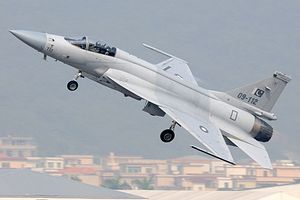China and Pakistan are developing a combat-capable two-seat trainer variant of the Pakistan Aeronautical Complex/Chengdu Aerospace Corporation (PAC/CAC) JF-17 Thunder combat aircraft, Flight Global reports.
“The only significant change to the aircraft apart from the extra seat is a dorsal fin that contains an additional fuel tank. This means the JF-17B’s fuel load is comparable to the single seater,” according to Flight Global. “Production of the first JF-17B was initiated by Pakistan and China during a joint ceremony at Chengdu Aerospace Corporation,” the Pakistan-based Dawn newspaper reported on April 28. CAC is located in Chengdu city in Sichuan province in southwest China.
A defense official working on the JF-17B program emphasized that there will be “no loss in combat capability with the addition of the extra seat.” Chinese and Pakistani representatives familiar with the JF-17N program have repeatedly said that a two-seat variant of the aircraft is under development. The first flight of the two-seat variant is planned for the end of 2016; the PAF plans to induct the first JF-17B in April 2017.
The JF-17 is a lightweight, single-engine, multirole combat aircraft, powered by a Russian-designed but Chinese-built Klimov RD-93 (RD-33 derivative) turbofan, capable of reaching a top speed of Mach 1.6. The fighter purportedly has an operational range of around 1,200 kilometers (745 miles).
According to IHS Jane’s Defense Weekly, the aircraft has “seven underwing/fuselage hardpoints, and is equipped with an internal GSh-23-2 twin-barrel cannon. Weapon options include up to four PL-5, -7, -8 or -9 short-range air-to-air missiles (AAMs) or four PL-12/SD-10B medium-range AAMs; two C-802A anti-ship missiles; two anti-radiation missiles; five 500 kg bombs; twin launchers for up to eight 250 kg, MK-20, GBU-12 or anti-runway bombs; single 1,000 kg bomb or GBU-10; or up to three mission pods.”
Pakistan purportedly has the capacity to assemble up to 25 aircraft per year without Chinese assistance. As I reported previously, Pakistan produces 58 percent of the airframe and China 42 percent respectively. The chief of air staff, Air Chief Marshal Sohail Aman, said this year in April that Pakistan intends to build a total of 24 fighter jets in 2016.
The JF-17 is in service with the Pakistan Air Force (PAF), where it is meant to replace the PAF’s aging fleet of of Dassault Mirage III/5 fighter jets by 2020. In April, the PAF inducted 16 upgraded JF-17 Thunder Block II fighter jets in Kamra, also known as Aviation City, the center of aircraft manufacturing in Pakistan (See: “China and Pakistan Air Forces Launch Joint Training Exercise”). Overall, there are 65 JF-17 aircraft currently in service with the PAF. Since its induction in 2011, the aircraft have accumulated a total of 19,000 operational flight hours.
The JF-17 Block II aircraft features upgraded avionics, an air-to-air refueling probe, an enhanced oxygen system, and an improved electronic countermeasures system, in addition to a number of smaller upgrades. Block II fighter jets also carry a heavier payload than Block I aircraft.
A number of countries have expressed interest in the JF-17, including Argentina, Bangladesh, Bulgaria, Nigeria, the Philippines, Venezuela, and Zimbabwe. Pakistan claims that it already has the JF-17’s first international customer. However, until now, Islamabad has not revealed the name of the Asian country that will procure the fighter jet.

































